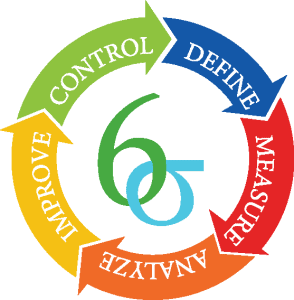Andrew Downard had a great post last week on the iSixSigma blog about the maturation of Six Sigma. He argues that Six Sigma has an “Act II” problem. Act II is all about institutionalizing Six Sigma so that it actually delivers on it’s promise. Downard argues that the skill set required for Act II is very different than what is required for Act I.
My language for this is the difference between Explorers and Settlers. In US history the explorers came from outside, mapped the terrain, and then moved on to the next place. Settlers came in and put up a cabin, plowed the earth, and settled in to make a difference. The actors in Act I are Explorers. The Settlers don’t show up until Act II.
But there is another way to look at this. If you do a Google Image Search for Six Sigma DMAIC, and then tally the images by type you get a very interesting perspective on Six Sigma. Of the first 40 images, about one half of them depict DMAIC as a linear process. Here is a typical graphic:
DMAIC as a Linear ProcessThe other half of the images, however, are cyclical. This one is typical:
I wonder if how we picture DMAIC indicates whether we’re an Explorer or a Settler, or in Downard’s terms, whether we’re in Act I or Act II.
I think it may also lead us to different conclusions about how we view data and data systems. If you’re an Act I Linear Explorer, I’m guessing you’ll see data and data systems as something that you need to conquer. Data is a wild river that holds some great fish that you can eat, but essentially it is blocking you from your next destination.
If you’re an Act II Settler, that same data river is something that can help drive subsequent cycles of the DMAIC process. In Settler terms you can use it to water your crops, drive a new sawmill, and (once you’ve invented them) power electric lights and a toaster.
If you’re an Act I Explorer, tools like GainSeeker Suite won’t make much sense to you. Who wants to build a hydro-electric dam when you’re just trying to get across the river?
But if you’re an Act II Settler, being able to connect to disparate data sources, collect and alarm based on statistical process control rules, and analyze for root cause of process variation becomes essential.
2 Comments
Comments are closed.


Evan, Great to see you blogging! I’ve added The Data Heads to my Six Sigma blogs feed and look forward to keeping up with all that wise data in your head.
Hi Evan,
Interesting post. I also repsonded to your comment on my blog.
I don’t think there can be any serious question about whether progress on process improvement (or whatever) is linear or cyclical. It would be very to hard to argue for the linear view – anyone who’s even dabbled in this kind of work knows that progress only comes through cycles, iterations, sideways moves, parallel paths, and other dance steps. The problem is that Six Sigma is typically SOLD as DMAIC, which implies linearity: simply complete this sequence of steps, and you’ll be done! And even better, the sequence is the same for every single project! For reasons that escape me, people repeatedly buy that concept, even though it doesn’t pass even the most basic critical inspection. I suppose it’s better than nothing, though even that is debatable.
Which is why you see all those cyclical models out there. DMAIC doesn’t actually work very well as advertised, so iterations are necessary. People good at DMAIC already know this, and their projects tend to look more like DMAAIIMMIIAADMAAAIIC (or whatever, you get the idea). My own view is that there are much better templates out there for iterative improvement – PDCA springs to mind, for example. Stringing several PDCA cycles together to create sustained improvements over time makes complete sense to me…doing DMAIC a bunch of times in a row, not so much. It can be done, and some people have become very good at it. But you’re taking a methodology that is clunky to begin with, and repeating it in a way that was never intended. We should at least consider the possibility that there are better ways to approach things from the start.
I guess what I’m saying is that perhaps the rise of cyclical DMAIC models, might simply be a response to inadequacy of the original linear model, as opposed to something more complex. Either way, it’s an interesting observation on your part!
Andrew.